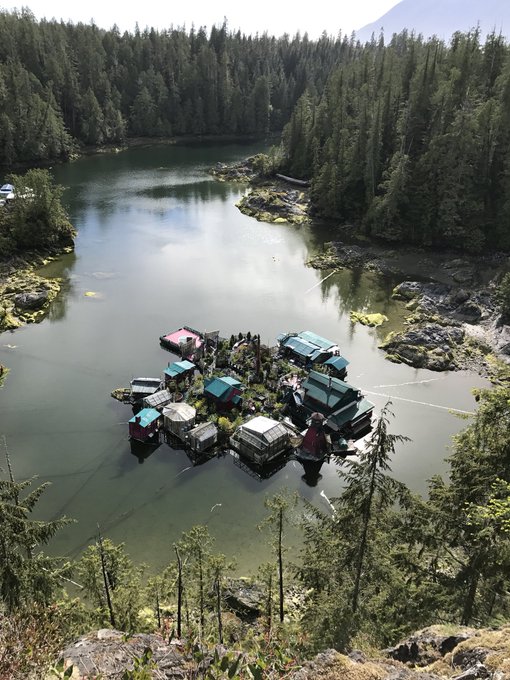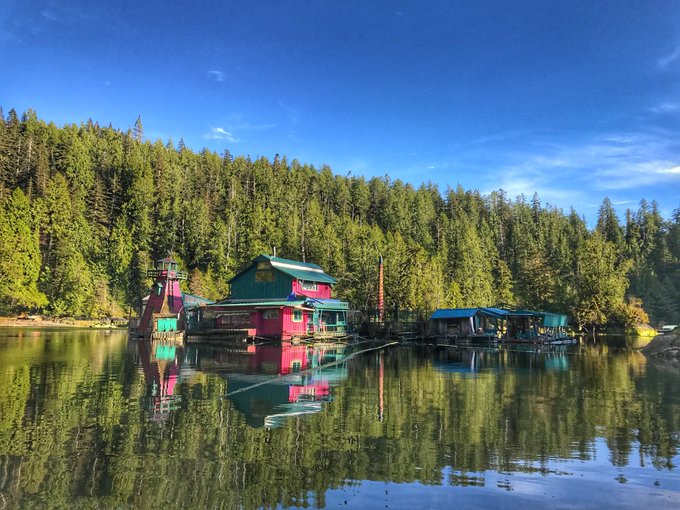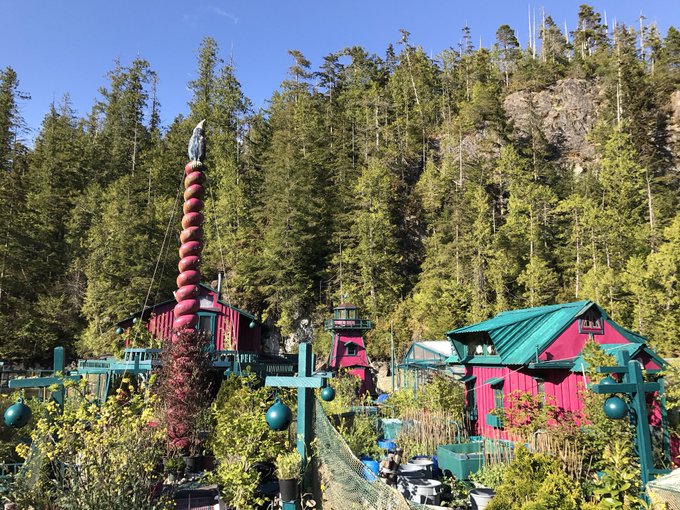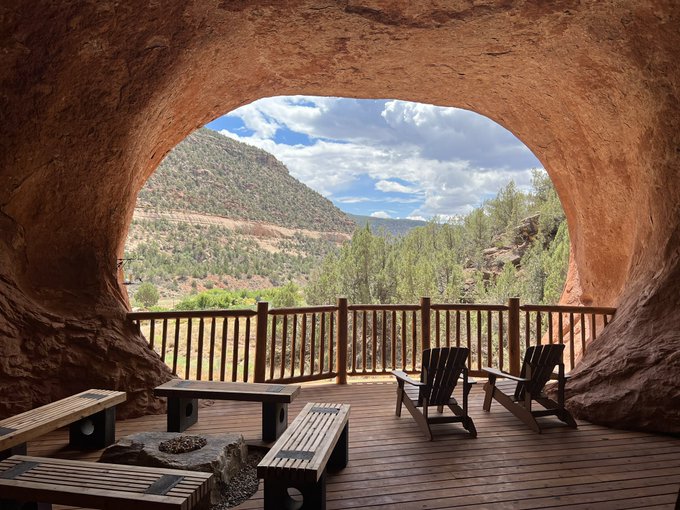Be it through living in gated communities or growing sky-high hedges, some homeowners really seem to value their privacy. But this article will investigate some homes that take secrecy a step further.
From man-caves in disguise to houses buried underground, these properties go to extreme lengths to stop nosy neighbors from peeking in. Let's play a game of hide and seek with the world’s most unbelievable hidden homes!
Honeycrock Farm
Back in the late 90’s, farm-owner Robert Fidler applied for planning permission to build a house on his land. When the local government took too long to get back to him, Fidler decided to fiddle the system by exploiting a loophole to build his dreamhouse without permission from the authorities.
In England, if an illegally built building has already been standing for four years without the council realizing, then the authorities can’t tear it down, as it’s considered an established building.
With this information,
Fidler secretly built the home himself and hid it from the authorities behind the haybales. The view inside wasn’t great, and horses kept chewing on his living room but after hiding the house for 4 years, Fidler finally pulled the hay down, revealing his home to the world.The house had been hidden in a haystack, but it was no needle. Fidler had built a mock Tudor castle, featuring turrets, chandeliers and a wood-furnished interior. The house even boasted a replica cannon, but unfortunately, the weapon didn’t fire, and it wasn’t able to stop the authorities from storming the castle and knocking at the door.

The local government argued that the house was built on protected land, and that removal of the haybales was a key part of the construction process. So, technically, the house’s construction was only completed once it was unveiled. This nullified the four years that the house was hidden, and legally, the home had to be destroyed. Fidler protested the council’s decision for over a decade, but he was clutching at straws and in 2016, Robert could only watch as a demolition crew
tore his dream home to the ground.
Private Homes in Public Commodes
Living in a toilet might not sound very glamorous, but it turns out, an old-fashioned public restroom might just be the best place to hide your apartment. The grand city of London is riddled with abandoned underground public toilets, most of them falling into disuse or disrepair over the decades due to budget cuts.
Architect Laura Jane Clark saw an opportunity in these run-down restrooms, purchasing a shut-down toilet in the Crystal Palace area, and
converting it into a home. From the sidewalk, this crapartment doesn’t look very homely, but once you head underground, urine paradise. Laura spent $80,000 converting the lavish lavatoire, and the result is flush with expensive furniture and stylish decorations.
Another incredible toilet conversion was idealized by an entrepreneur from Los Angeles, who’s built an entire business out of
creating homes from porta-potties. Between 2012 and 2018 homelessness in L.A. rose by 75%, and inventor TK Devine decided to do something about it, starting the porta-home project. From the outside, this large, wheelchair-accessible porta-potty might look like a dump, but Devine’s converted the throne into a home, the interior featuring a murphy bed, a fridge, a desk and storage space.
Portable Toilets Converted Into Homes May Help With Homeless Crisis by CBS LA The final design is more of a poop-plex than a dung-galow, featuring two connected porta-potties; one of which is for genuine toilet use! Amazingly, these commode abodes come with a rooftop garden, and an outdoor seating area. The homes cost around $20,000, but TK’s charity Our Backyard Homes aims to raise money to build the porta-homes and donate them to homeless charities, helping the thousands who are forced to sleep on the streets or squat in abandoned buildings. Because, in TK’s book, the only squatting anyone should ever have to do is on the toilet.
Clocktower Condominium
In a city as big as New York, privacy can be hard to come by. But this luxury apartment in Brooklyn offers a unique solution to the problem by hiding itself inside an old clocktower.
Proving that time is money, this one-of-a-kind property is one of the most expensive apartments in Brooklyn,
clocking in at $15 million when it sold back in 2017. Inside, the glass clock face floods the space with natural light, offering the owner incredible views of Brooklyn Bridge and the Manhattan skyline.
Crane 29
From afar, it might look like an ordinary crane, but as you get closer, you’ll notice the machine’s grass topped roof and metal balcony; features that are better suited to a country house than a construction site.
This is
Crane29, found in Bristol, England and created by Canopy & Stars, a luxury camping company that usually deals with treehouses and cabins hidden out in the wilderness. This industrial take on the treehouse concept, however, was constructed in one of the city’s many dock-side cranes.
Inside, Crane 29 is a haven for hipsters, and the occupants of the hotel room are more likely to sport man-buns than hard hats. The room contains a forest of house plants, an indoor hammock, and a large collection of books, the crane specializing in lifting spirits, instead of concrete.
Some crane hotels are even more effectively hidden, almost entirely unnoticeable to the outside world.
Crane Hotel Faralda is a luxury hotel in Amsterdam, hidden away in a vibrant neighborhood that used to be a shipping wharf. In 2011 businessman Edwin Kornmann Rudi decided that a crane-themed building in the old docks would be the perfect homage to the area’s past. So, he built the crane hotel, using a real crane!
Crane Hotel Faralda Montage by Faralda Crane Hotel Today, a night’s stay in one of the Crane Hotel Faralda’s three suites will cost you around $1,000, but if you’re scared of heights, it may be worth saving the cash. The crane is 165 feet tall, and the top offers unbelievable views of Amsterdam. Thankfully, the trip back down is quick, as the
hotel offers a bungee jumping experience for its bravest guests, allowing you to leap from the top of the crane. It's probably faster than taking the stairs.
Jules’ Undersea Lodge
Sleeping with the fish might sound like a threat from a Mafioso, but at Jules’ Undersea Lodge in Key Largo, Florida, you don’t have to mess with the mob to snooze below the waves. At Jules’ you can scuba dive down and spend the night in a converted underwater research laboratory.
The hotel’s wide-windowed view is always filled with tropical angelfish, parrotfish, barracuda and snappers, and you enter the lodge through a ‘moon pool,’ swimming up through an open entrance on the floor of the building.
Jules' Undersea Lodge full walk through by tokillamurderer The freaky front door might look like witchcraft, but the explanation is actually pretty simple. A tube to the surface command-center fills the lodge with compressed air, stopping the water level from rising up through the hole and flooding the hotel, while also allowing guests to breathe freely.
At $900 a night, staying at Jules’ might feel like splashing out, but the price also includes the world’s first underwater pizza delivery! Nobody likes soggy pizza, so the team at Jules’ place a Papa John’s pizza in a watertight container, before a scuba-diving delivery boy swims the 30ft down to deliver the pie. With slightly cramped rooms and porthole doors, staying at Jules’ isn’t the most glamorous experience, but the future of underwater living might be a bit more luxurious.
The
H2OME concept is a proposed undersea mansion with over 3,600 feet of living space, featuring a library, a dining room, and huge bedrooms with ocean views. The home is designed to be fully submersible, apart from a long tube that runs to the surface, containing an elevator and a spiral staircase.
The project was developed by US Submarine Structures, but unfortunately, the company’s funding wasn’t as airtight as the H2OME's, and the project’s development was put on hold back in 2008. Still, if this idea ever gets off the ground or under the water, then living on the seabed could be about as private as it gets!
Archway Studios
For centuries, trolls have had a stranglehold on the ‘under the bridge’ property market, but if you catch a train down to London, you too can get an opportunity to live under the tracks.
A tagged-up bridge in Walworth might not look homely, but it’s all a rusty ruse. If you head through its deceptive doorway, you’ll find yourself in
an apartment with glowing white walls and a curved ceiling, the designers incorporating the shape of the bridge into the home.
Being so close to the tracks might put some people off, but if a train does fly overhead, you don’t have to plug your ears. The entire house is built on rubber foundations, and the outer walls are cocooned with fiber insulation. This creates a protective blanket that absorbs the sound of passing trains, wrapping the whole house up like a big sound-proof hug. Which is arguably the best kind of hug you could hope for under a dilapidated bridge in a rough part of town.
Coober Pedy
In South Australia, there’s a town called Coober Pedy that takes the term ‘down-under’ to a whole new level, as around 60% of the population live in caves underground. They aren’t living like cavemen though, their below-ground dwellings containing double rooms, bars and even swimming pools.
This Is the Town Where People Live Underground – Coober Pedy | World's Most Extreme by Channel 4 Documentaries Unlike the other homes in this article, the houses in Coober Pedy aren’t hiding from people; they’re hiding from the sun. The town is in the middle of the Australian Outback, where surface temperatures can reach up to 123 degrees Fahrenheit, burning you up like a shrimp on the barbie. In comparison, rooms in the underground houses stay at around 73 degrees, cooled by the insulating surrounding rock, regardless of the weather outside, protecting homeowners from the worst of the Australian sun. You may be wondering why people bother living in such an inhospitable place at all.
The answer? Opals. Back in 1915, a teenager found an opal in the middle of the Australian outback; a beautiful gem sparkling in the dust. As news of his discovery spread, miners across Australia picked up their pickaxes and rushed to the area, trying to find their fortune.
Over time, the mining settlement grew, and the town now features underground hotels, churches and its very own above-ground golf-course! The town is still filled with generations of treasure-hunting miners.Sometimes, while digging through the rock to build a new house, they’ll stumble upon an opal that’ll cover the cost of their new home! A word to the wise, though: if you don’t live in Coober Pedy, don’t go digging through your walls to find opals. All you’re gonna find is water pipes and angry neighbors.
ESO Hotel
The ESO Hotel may look like a building hidden away on Mars, but it's located in the Chilean desert. It used to house astronomers as they carry out research in nearby telescope array observatories.
Architect Fritz Auer wanted to design a building that didn’t spoil the natural desert landscape around the ESO hotel, so the building is hidden between two hills, with a concrete exterior that blends in with the colors of the desert. ESO stands for the European Southern Observatory, a joint government organization run by 16 Western European countries. They chose this part of the Chilean desert for their work as it’s far away from civilization, high above sea level, and it has more than 350 cloudless days a year; making it the perfect place for the organization to do some stargazing.
The hotel provides guests with a pool, and a jungle of indoor plants, making sure that the astronomers feel at home during their stay. The ESO hotel doesn’t just observe the stars, it houses them too, and you may remember the building getting blown up by James Bond in 2008’s
Quantum of Solace. Unfortunately, the hotel isn’t open to the public, so if you want to spend a night in the hidden building, you’ll have to become a European astronomer or Daniel Craig.
Barndominiums
At first glance, this ordinary barn in McKinney, Texas looks like it should house horses and hay. But once you open the door, you’ll discover a home like a penthouse apartment, featuring a bar and all the bells and whistles of a luxury mansion.
Deceptive buildings like these are called Barndominiums, built by a McKinney company called Morton Buildings. The cost to convert a regular barn to a barndominium ranges from $80,000 to $200,000, and the team at Morton say that they’ve now built thousands of the homes.
Everything is bigger in Texas, but surprisingly, these giant houses aren’t only built in the lone star state. In 2009, a crooked businessman from England called Alan Yeomans declared bankruptcy, telling the authorities that he’d moved into a shed at the end of his mom’s garden, with just $405 to his name. In reality, Yeomans had created a barndominium of his own, using laundered money to build a six-bedroom mansion that was designed to look like a huge green barn.
After an investigation, the cops raided the shed, discovering a treasure trove of antiques, jewelry and oil paintings worth over $80,000. If that wasn’t crooked enough, the police also discovered a secret door behind a painting that led to a greenhouse, where Yeomans was growing $40,000 worth of illicit plants.
Antiques and cannabis: Police reveal inside Yeoman's Manor home - Daily Mail by Daily Mail World After the raid, all of the ill-gotten valuables were sold at auction, and
Yeomans was sentenced to six and a half years in prison, trading his illicit barn for iron bars.
Earth-Tent
Living in a tent might not sound glamorous, but the so-called Earth-Tent in Crete is hardly a teepee. From above, the property looks like a series of alien symbols carved into the Earth. But the space-age home was designed in Greece, not on Mars, created by the team at DECA Architecture.
The Earth-Tent’s beauty is on the inside, and the home’s interior features a huge open-plan living space that’s bathed in natural light. DECA Architecture say that they’re trying to build a house where the ‘boundary between interior and exterior is lost.’ What they truly mean is: The Earth-Tent doesn’t have a roof, or any doors. DECA don’t explain what happens when it rains, but fortunately, the Earth-Tent is still in the design phase, so they have lots of time work out those details.
The home’s topless design might have you worried about burglars, but fear not, even the savviest criminals are gonna have a hard time finding the place. The Earth-Tent is positioned on top of a hill, so it’s nearly invisible from the surrounding area. Even the house’s driveway is sunk into the ground, meaning that you can’t actually see the home until the moment that you arrive. In case you've spent plenty of sleepless nights in tents, a night in the Earth-Tent might look like your kind of camping.
Landslide
Up next is another hillside house designed by DECA Architecture, and this home’s so hidden, it’s probably a health hazard. From the mainland, the only visible part of Landslide is a rectangular hole, dug into the Earth, and if you’re not careful you could easily trip into the luxury villa.
There are worse holes to fall into though, and when you look down into Landslide, you don’t see dirt and worms, you see the heights of luxury. The home has three en-suite bedrooms, a spacious lounge and an open-plan kitchen, all spread out over one long floor.
From the ocean, the house is a bit more visible, but once the villa’s complete, it’s going to be fitted out with a wooden façade, making it even harder to find! Where privacy’s concerned, this place is a landslide victory!
The MirrorCube
Next up, we have a hidden home that’s all oak and mirrors, an optical illusion built in the middle of a forest in Sweden. The MirrorCube is a near-invisible treehouse, surrounded by a one-way mirror, allowing guests to look out of the windows, while staying hidden from the world outside.
Image data not available
The one-way mirror is actually normal glass, coated in an incredibly thin layer of reflective metal. Like an ordinary mirror, when light hits the glass, it’s reflected back at the onlooker. However, on one-way mirrors, the layer of reflective metal is so thin, that some of the sunlight passes through into the MirrorCube, allowing the guests inside to see out through the glass.
A night at the floating home starts at $559, but there’s only room for two inside the room’s minimalistic plywood interior. At 13 cubic feet, the MirrorCube is like a compact mirror tucked into a handbag, but for introverts looking for a getaway, this cozy hotel is a dream come true. If you love the MirrorCube, but hate heights, then fear not, because it isn’t the only mirrored home hidden out in the wild. The
Invisible House is designed to look like a toppled skyscraper, lying on its side in the middle of Joshua Tree National Park, California. This horizontal Hi-rise might not be tall, but it’s certainly lofty, including 90 acres of private property, a 100-foot swimming pool, 4 king-sized beds, an 86” TV and a transparent electric guitar because why not?
If that strikes a chord with you, then you can rent the home on Airbnb for $4,500 a night. Leave plenty of time for travel though, I hear finding the place is a nightmare.
Down to Earth Tree Houses
This next home is an ordinary, albeit square house with a camouflage jacket on, blending into its surroundings like a rectangular commando. This grounded treehouse is called Juniper House, and the exterior cloth layer is designed to look like a cluster of pine trees, disguising it among the surrounding woods.
Designed by Murman Architects in Sweden, the external invisibility cloak allows the homeowners to live out in the wild, without ruining the woodland scenery. If you were walking through the woods, Juniper House would definitely make you do a double take, but compared to the next hidden property, its disguise is as basic as a fake mustache.
Woodpile Studio is a house that’s designed to look like a pile of logs, its true nature only revealed when its owner decides to open the windows, or head outside.
Hans Liberg in his Piet Hein Eek cabin by hanslibergtv The hide and seek home’s creator isn’t a lumberjack; he’s a Dutch designer called Piet Hein Eek who built the house for his friend; musician Hans Liberg. The cozy, single-room home is the perfect getaway, letting Hans escape to nature and log off from the world for a while.Sometimes, we all want to leave society behind and live out in the middle of the woods but then we remember flushing toilets, hot showers and sweet, sweet Wi-Fi. The owner of the next hidden house solved that problem by bringing the woods to them, planting a row of trees around their property that blocks off the outside world.

The reasoning behind this reclusive garden isn’t just social anxiety. On wide open farmland, the wind can get pretty intense, so tall trees are often planted around buildings and fields to protect them from the weather. This home’s privacy is just a fortunate consequence of its camouflage windbreaker and living in the isolated home sounds like absolute heaven until you hear somebody shout ‘timber.’
Jungle House
The forests in Brazil are some of the most inhospitable places on Earth: home to anacondas, tarantulas and, this luxury mansion. Designed by Studio MK27, this house lies on the edge of the jungle near the city of Guarujá, and it’s completely surrounded by nature. Its wooden slat design helps it to blend in with the jungle’s dense vegetation.
In the Jungle house, the rainforest’s creepy crawlies can’t reach you, as the entire luxury mansion is raised off the ground, far above the forest floor. This allows the home to rise above the canopy, affording the owner plenty of natural sunlight. Despite its wild-seeming location, the house is incredibly advanced and modern, featuring a huge swimming pool, a firepit, and several bedrooms, all spread over three separate stories. Forget King Louie, whoever owns this house is the king of the jungle.
Freedom Cove
Out in the Canadian wilderness lies a man-made island, hidden away from civilization. Freedom Cove is the life project of artists Wayne Adams and Catherine King, a married couple who’ve bobbed around onboard the floating home for 30 years.
The couple had always dreamt of running away and living in nature, and as rent prices in their town started to go up, they decided to rock the boat and live a less conventional lifestyle. Over the years, Freedom Cove has slowly grown larger and larger, and the ever-expanding collection of wooden barges and boats that make up the home’s foundations are now topped with gardens, art studios, bedrooms and a dance floor. All of this was completely hand-crafted by the couple without the use of power tools; the hard work fueled by a diet of vegetables grown in the garden and fish caught by Wayne. Fish which, on occasion, Wayne catches from the comfort of his couch through a hole in his living-room floor!
Off the Grid on a Homemade Island by Great Big Story On the rare occasion that they have to leave the island, the couple joke that they feel ‘land-sick,’ as their bodies have become acclimatized to floating around 24/7. They don’t plan on ever moving out of Freedom Cove, and want to live onboard until the end, going down with the ship.
Cliff Haven
The next hidden cave-house is a lot more than just a hole in the wall. The Cliff Haven is heaven for introverts, a spacious, off-the-grid house that was hand-carved into the side of a cliff back in the late 80’s.
The home is 20 minutes away from the city of Monticello, Utah, hidden away on 12 acres of private land with an orchard, a vineyard, solar panels and rainwater collection tanks. With all those amenities, the anti-social owner can be completely self-sufficient, hiding away in the cave house forever! If that lifestyle sounds too lonely, then the house also contains three bedrooms, 2 bathrooms and a two-car garage, meaning that there’s more than enough room to invite a friend. Who wouldn’t want to move to Utah and live like the world’s fanciest caveman?





































